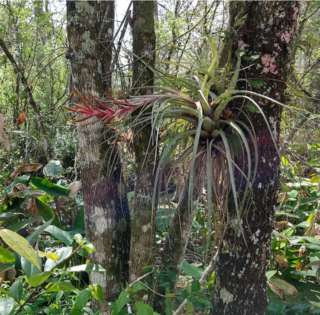
Bromeliad Life History, Nutrient Cycling, and Conservation Biology
Brad Oberle and collaborators
Epiphytes — plants which grow on other plants — abound in tropical ecosystems, where they represent as many as half of all species present. One of the most diverse and distinctive families of epiphytic plants in the neotropics is the Bromeliaceae. Relatives of pineapples, Bromeliads have relatively simple structures consisting of whorled strappy leaves with a terminal flowering bud. However, their reproductive and nutrient strategies are diverse, with important implications for rare species conservation and forest nutrient cycling. With respect to reproductive strategy, some species are iteroparous and flower many times, while others are semelparous and flower just once, often spectacularly, just before death. Semelparous species may be especially vulnerable to conservation threats from illegal collections and introduced pests. Most bromeliad species of either reproductive strategy live their entire lives in forest canopies without ever touching soil. Some acquire nutrients directly from the atmosphere; others obtain nutrients from complex biological communities that form their water holding-leaf bases; a few actively attract and digest animals. These varied strategies have profound effects on nutrient cycling and biological diversity in neotropical forests. To better understand bromeliad life history, nutrient cycling and conservation, I partner with colleagues in higher education and other botanical gardens.

Cardinal airplant (Tillandsia fasciculata) blooming in Corkscrew Swamp Preserve, Naples, FL. Cardinal airplant is an iteroparous bromeliad that forms tanks in their overlapping leaf bases.